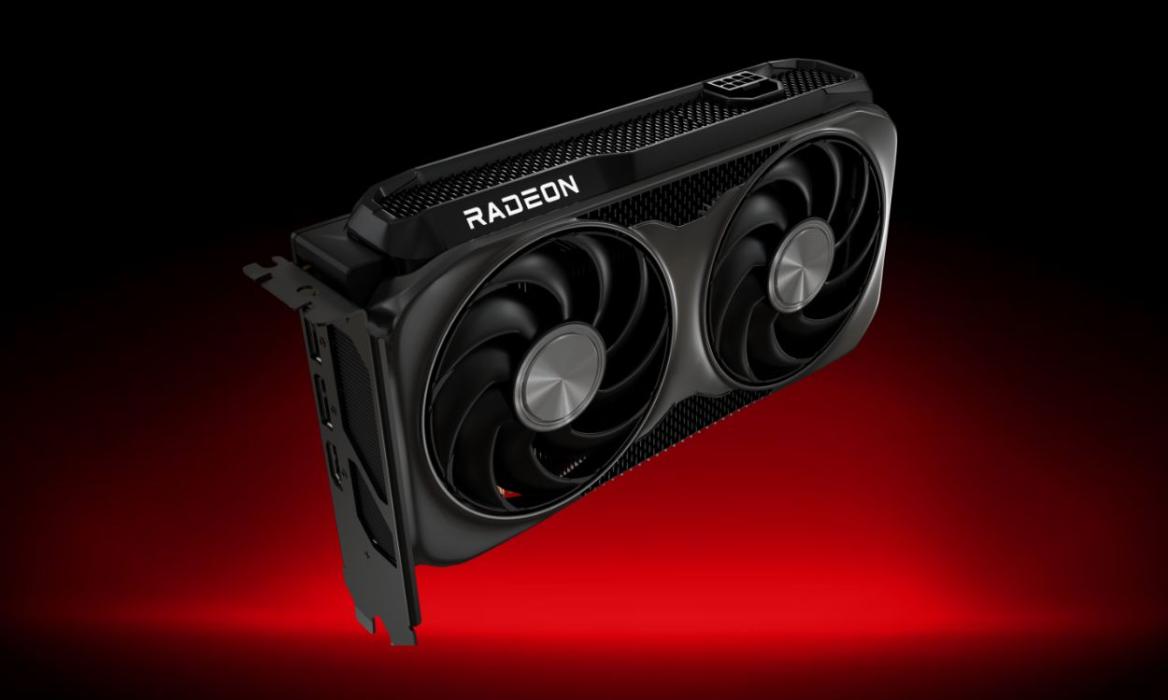AMD used the Computex 2025 stage to unveil a pivotal addition to its RDNA 4-based lineup: the Radeon RX 9060 XT. Positioned just below the RX 9070 and RX 9070 XT, this mid-range graphics card is designed to deliver a compelling entry point for gamers and creators seeking modern RDNA 4 technology without climbing into the top tier. The introduction signals AMD’s intent to broaden the RDNA 4 ecosystem with a more accessible option that still leverages the architectural enhancements that define the generation. As AMD frames it, the RX 9060 XT is not merely a smaller sibling but a strategically important model intended to flesh out the product stack and offer a seamless upgrade path for mainstream buyers who want robust performance without paying a premium for the flagship parts.
The RX 9060 XT marks a notable shift in AMD’s chip strategy for the mid-range tier. To manage cost while preserving performance, AMD has opted for the Navi 44 GPU fabric instead of the Navi 48 silicon used in the RX 9070-series cards. Navi 44 is the cornerstone of this SKU, making the RX 9060 XT the first product to employ this chip, with AMD signaling that more RDNA 4 devices will likely roll out using Navi 44 as the lineup expands. This choice aligns with the broader goal of offering competitive power, efficiency, and feature sets at a friendlier price than the higher-end Navi 48-based GPUs. The result is a card that aims to deliver solid real-time rendering capabilities, with enough headroom to drive modern titles at respectable settings, while keeping heat and energy use within familiar bounds for a mid-range gaming system.
The RX 9060 XT is positioned as the successor to 2024’s RX 7600 XT, a model that enjoyed strong demand in the mid-range segment until competing products from Nvidia, especially the RTX 5060 Ti family, reshaped the competitive landscape. In AMD’s framing, the RX 9060 XT’s introduction reasserts the company’s commitment to delivering competitive value in the sector and to counter the perceived market shifts triggered by Nvidia’s offerings. The 9060 XT’s design emphasizes a balance between performance and efficiency, with the architecture tuned to appeal to gamers who want smoother frame rates, capable ray tracing, and robust AI-assisted upscaling at a reasonable price point. AMD’s approach here appears to be about elevating mid-range expectations rather than merely replacing a previous generation.
From a core technology standpoint, the RX 9060 XT ships with 32 Compute Units, which translates to 2048 cores, accompanied by 32 ray tracing (RT) accelerators and 64 hardware AI accelerators. This configuration positions the card well for tasks that rely on both traditional rasterization and modern AI-assisted workloads, including upscaling, denoising, and other image-enhancement tasks. The boost clock can reach up to 3.13 GHz, showcasing the efficiency and performance headroom offered by the TSMC 4nm manufacturing process. That same process choice enables a higher level of performance per watt, a critical consideration for mid-range GPUs that need to balance cooling and power budgets in a diverse array of system builds.
The RX 9060 XT also claims a significant performance upgrade in ray tracing relative to its predecessor, boasting double the raytracing output compared to the earlier model. In practical terms, this translates into more robust realism in scenes that rely heavily on ray-traced lighting, shadows, and reflections. AMD cites a peak performance figure of 821 TOPS (tera-operations per second) for the card, underscoring its capabilities in compute- and AI-accelerated workloads that extend beyond traditional gaming workloads. This synergy of compute power, ray tracing prowess, and AI acceleration paints a picture of a card designed to remain relevant as titles push toward more sophisticated rendering pipelines in the years ahead.
On the power side, the RX 9060 XT presents a workable envelope of 150W to 182W, depending on usage scenario. This range makes the card approachable for a broad audience, including many standard power supply units without requiring extreme high-widelity cooling solutions. The card will be offered in two memory configurations: 8 GB and 16 GB, both using a 128-bit memory bus with GDDR6 running at 20 Gbps. This configuration provides a solid balance between memory bandwidth and total VRAM capacity, supporting 1080p, 1440p, and even 4K gaming at acceptable settings in many titles, particularly with upscaling enhancements from FSR 4 in play.
In AMD’s published benchmarks, the Radeon RX 9060 XT 16 GB variant is claimed to be up to 6% faster than the RTX 5060 Ti 8 GB, a claim that is meant to be interpreted in the context of price and overall performance envelope. While not presented as a one-to-one comparison across all titles and settings, AMD’s intent is to demonstrate competitive performance within the mid-range segment and to justify the RX 9060 XT’s value proposition alongside the 16 GB memory configuration. The RX 9060 XT 16 GB is priced at $349, while the 8 GB variant is priced at $299, positioning the card as an affordable option for gamers who want higher memory capacity or a lower-cost entry point, respectively. AMD has scheduled the RDNA 4 release for June 5, a date that signals readiness for retailers and system builders to begin integrating the new GPU into a broad set of PC configurations.
In terms of display capabilities, the RX 9060 XT provides DisplayPort 2.1a and HDMI 2.1b support, setting it apart from some earlier mid-range models that offered more modest I/O. This combination enables higher bandwidth options and better support for contemporary monitors with the latest connectivity standards, enhancing the potential for high-refresh-rate gaming at high resolutions. This is a notable upgrade over the RX 7600 XT, which delivered DisplayPort 2.1 and HDMI 2.1a, underscoring AMD’s intent to future-proof the mid-range with modern I/O features. The inclusion of these display interfaces aligns with consumer expectations for flexible multi-monitor setups and the ability to engage with next-gen display technologies.
When it comes to upscaling and image quality enhancements, FSR 4 remains a cornerstone for AMD’s RDNA 4 flagship strategy, and the RX 9060 XT is well-positioned to leverage these capabilities. The mid-range GPU will be one of the first to benefit from the broader FSR 4 ecosystem, and AMD signaled ongoing development and refinement in this area. The company also announced a major upgrade in the FSR family: FSR Redstone, a new layer of upscaling technology intended to produce significant visual fidelity gains and performance improvements. Redstone includes neural radiance caching, ray regeneration, and machine learning-based frame generation. These features are designed to enhance image quality and deliver smoother frame rates, particularly in graphically intense scenes, and they will be exclusive to RDNA 4 GPUs at launch. The introduction of Redstone demonstrates AMD’s commitment to using AI-driven techniques to push the boundaries of what mid-range hardware can deliver.
Beyond GPUs, AMD also teased the launch of new Zen 5-based Ryzen Threadripper CPUs, emphasizing the company’s push into high-end desktops and powerful workstations. At the pinnacle sits the 9980X, a 64-core flagship model designed for extreme multi-threaded workloads and professional-grade tasks that demand substantial parallel processing power. The 9970X is described as having half the core count of the 9980X, which would place it at 32 cores, while the 9960X comes with 24 cores. All three CPUs are said to offer peak boost frequencies up to 5.4 GHz, underscoring AMD’s ambition to deliver not only formidable graphics capabilities but also a strong, competitive CPU lineup to complement the RDNA 4 ecosystem. The pricing and availability of these Threadripper models remain to be announced, but the trio’s presence at Computex signals AMD’s intent to address the needs of enthusiasts, creators, and professionals who require significant CPU headroom in tandem with a capable GPU.
This Computex 2025 showing thus consolidated AMD’s strategy around RDNA 4 as a holistic ecosystem, with the RX 9060 XT serving as a versatile mid-range option and Redstone underpinning upscaling and AI-assisted rendering across the lineup. The combination of Navi 44-based GPUs, higher-end DisplayPort and HDMI support, and a robust AI-enhancement toolkit positions AMD to appeal to gamers, content creators, and professionals who demand efficient performance across a wide range of workloads. As AMD positions its RDNA 4 family, the company’s focus on balance—between compute, raster performance, AI acceleration, and upscaling—reflects a broader industry move toward intelligent hardware that can deliver better results with improved efficiency.
As for what this means for consumers, the RX 9060 XT offers a compelling choice for those who want modern RDNA 4 features without paying flagship prices. The two memory configurations enable buyers to tailor VRAM to their gaming needs and budget, while the 128-bit bus and 20 Gbps memory provide a healthy bandwidth profile for its class. The release date of June 5 ensures a timely entry into the market, aligning with a period of heightened interest in mid-range GPUs that can handle the latest titles at reasonable settings. The DisplayPort 2.1a and HDMI 2.1b support ensures that users with the newest displays aren’t left wanting for connectivity or bandwidth, and FSR Redstone’s planned introduction is likely to become a defining feature of the RDNA 4 mid-range experience. In short, the RX 9060 XT is more than a successor to a previous generation—it is a carefully designed mid-range proposition that leverages Navi 44, a strong AI upscaling toolkit, and a competitive price point to deliver broad appeal.
In the broader Computex narrative, AMD’s announcements extended beyond the RX 9060 XT to a major refresh of its AI-assisted upscaling and to high-end desktops with Zen 5 Threadripper CPUs. The company’s emphasis on FSR Redstone, neural radiance caching, ray regeneration, and ML frame generation articulates a defined path for RDNA 4’s role in future gaming and content-creation workflows. It signals that AMD is betting on AI-centric improvements to stay competitive with Nvidia’s DLSS ecosystem and to deliver consistent gains in both performance and image quality through software-driven enhancements. The Threadripper family’s potential 64-core configuration represents a bold statement about AMD’s ambitions in the workstation market, where raw processing power, multi-thread efficiency, and high boost clocks are essential. The combination of a new mid-range GPU, enhanced upscaling technology, and a high-end CPU family illustrates a holistic strategy to attract a diverse set of users—from casual gamers to professionals working with intense rendering pipelines.
From a reader’s perspective, these announcements paint a picture of a highly integrated platform, where the GPU, CPU, and software tools work in concert to deliver improved gaming experiences and creator workflows. The RX 9060 XT’s Navi 44-based design is framed as a practical compromise that avoids the complexities and costs of Navi 48 while still delivering notable performance and modern features. The FSR Redstone upgrade points to a future where AI-driven upscaling and image enhancement become core to mid-range and high-end graphics, rather than a supplemental add-on. Meanwhile, the Threadripper lineup is framed as a strategic extension of AMD’s desktop performance story, reinforcing the company’s commitment to the entire ecosystem—from silicon to software—to deliver results that compete effectively in a market increasingly defined by AI-capable hardware and sophisticated rendering pipelines.
As AMD’s Computex 2025 presentation wraps up, the question for enthusiasts, professionals, and system builders becomes which announcements will translate most directly into tangible performance gains and price-to-performance improvements in real-world scenarios. The RX 9060 XT’s blend of Navi 44 power, 3.13 GHz boost potential, 128-bit memory interface with 20 Gbps GDDR6, and a $299–$349 price range establishes a solid baseline for mid-range gaming setups that want modern features without overspending. The FSR Redstone suite promises to elevate rasterization and AI-assisted fidelity, while the Threadripper CPUs offer a compelling option for users who need massive multi-core performance for workloads such as video editing, 3D rendering, and scientific simulations. In practice, gamers may find the 9060 XT a particularly attractive choice for 1440p gaming with high-quality ray tracing and upscaling enabled, while creators and professionals may value the CPU and GPU pairing for demanding workflows. The stage is set for a dynamic period in the PC ecosystem as AMD expands its RDNA 4 footprint and lays the groundwork for future innovations that will likely continue to shape how games look and how content is produced.
Conclusion
AMD’s Computex 2025 showcase positioned the Radeon RX 9060 XT as a pivotal mid-range offering within the RDNA 4 family, leveraging Navi 44 to balance performance and cost while delivering modern features such as DisplayPort 2.1a, HDMI 2.1b, and robust AI upscaling potential. The release date of June 5 and the price points of $299 for the 8 GB model and $349 for the 16 GB variant reflect a strategic approach to price-to-performance in the mid-range segment, pushing back against competition while recognizing the value of memory capacity in modern titles. The overarching strategy, however, extends beyond a single SKU. AMD’s rollout of FSR Redstone — with neural radiance caching, ray regeneration, and machine learning frame generation — signals a broader commitment to AI-enhanced visuals and performance improvements that are exclusive to RDNA 4 at launch. The company’s broader hardware push, including Zen 5-based Ryzen Threadripper CPUs—top-tier products with the 9980X at 64 cores and the 9970X at 32 cores, with all three models offering hypothetical 5.4 GHz peak boosts—reinforces a long-term vision for an integrated, high-performance platform for gaming, content creation, and enterprise workloads.
For readers and industry observers, the Computex 2025 announcements invite a careful appraisal of how the RX 9060 XT and its RDNA 4 ecosystem may reshape the mid-range segment. The card’s emphasis on modern I/O, substantial but accessible memory configurations, and advanced upscaling technology suggests that AMD is wagering on strong real-world value for a broad audience. As the market absorbs these developments, questions will increasingly focus on real-world performance across a wider array of titles, driver maturity, software integration with Redstone’s ML-driven enhancements, and how Threadripper’s high-core-count CPUs will fare in conjunction with RDNA 4 GPUs in demanding professional workloads. The next months will reveal how these announcements translate into actual product performance in diverse systems and use cases, but the foundations laid at Computex 2025 indicate AMD’s resolve to push RDNA 4 as not only a flagship technology but a practical, broadly adoptable platform that can power both entertainment and professional productivity.



